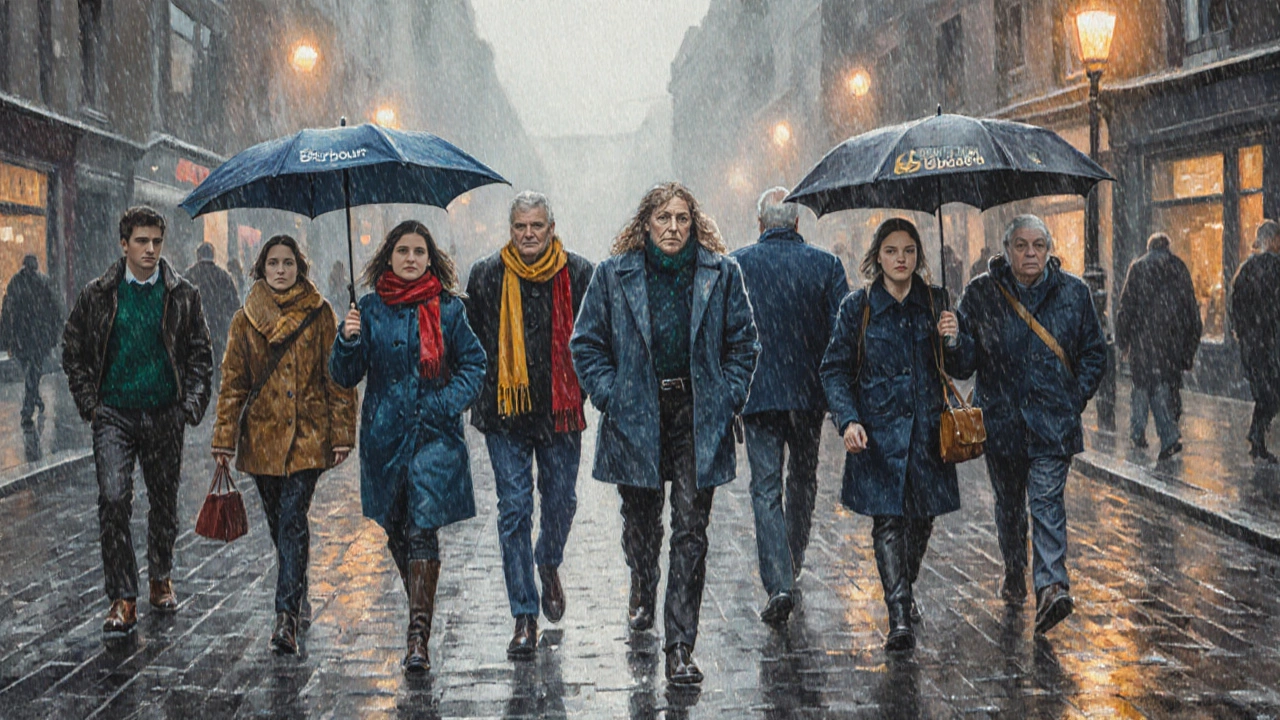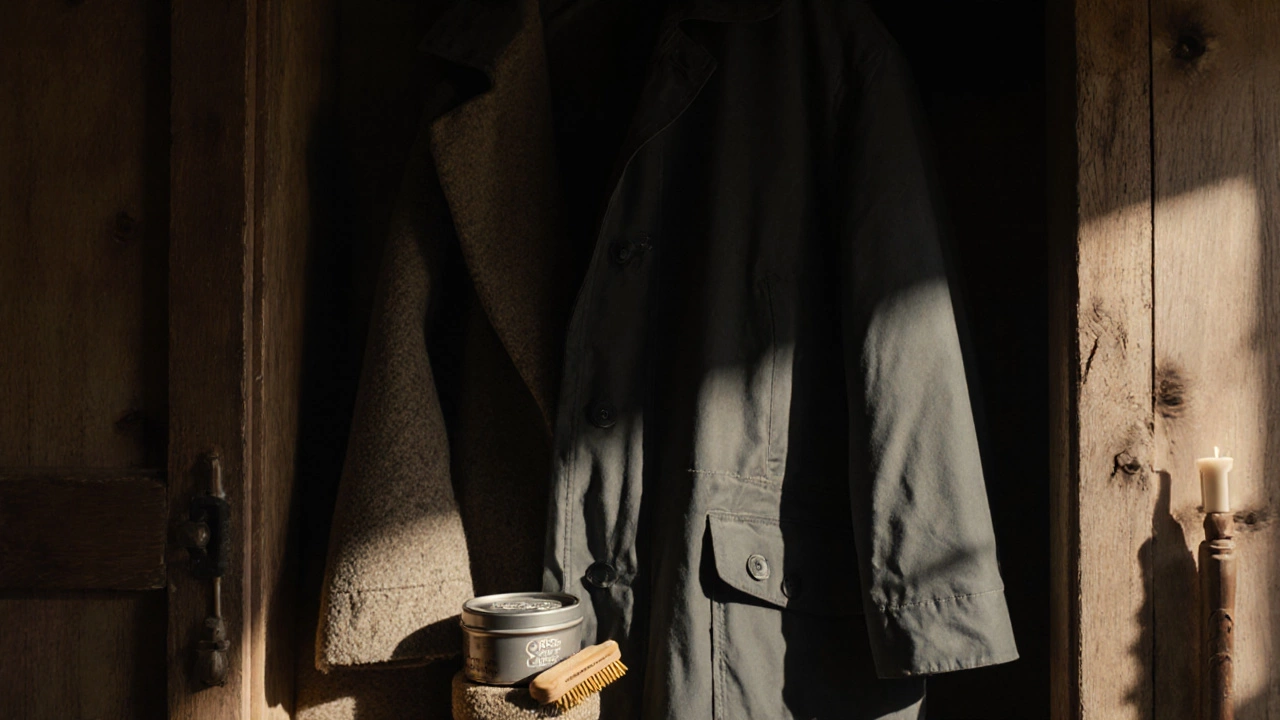In Ireland, where rain doesn’t fall-it pours, and wind doesn’t blow-it howls through the hills of Connemara and rattles the windows of Dublin’s Georgian terraces-the jacket isn’t just fashion. It’s survival. You don’t choose a jacket here; you jacket up before stepping out the door. But why do we call it that at all? The word isn’t Irish, yet the thing itself is as Irish as a pint of Guinness on a wet Tuesday in Galway.
The Word That Weather Made
The word "jacket" didn’t come from Gaelic. It came from French-"jacque"-a short, padded coat worn by medieval soldiers and laborers. By the 1500s, English sailors started using it to describe the short, sturdy coats they wore on deck. Over time, "jacket" became the go-to term for any outer layer that kept you warm, dry, and out of the wind. In Ireland, where the Atlantic storms roll in without warning, that definition stuck like mud on boots.Unlike in warmer climates where jackets are seasonal, here they’re a year-round necessity. You’ll see farmers in Tipperary wearing waxed cotton jackets from Barbour, students in Cork zipping up into waterproofs from Rab, and tourists in Killarney bundled in Patagonia fleeces-all because the weather doesn’t care if it’s June or December. The jacket in Ireland isn’t a fashion accessory. It’s a tool. A shield. A second skin.
From Waxed Cotton to Windproof Wool
Irish jackets have evolved, but their purpose hasn’t changed. The classic waxed cotton jacket-originally developed for British hunters and fishermen-became a staple here after World War II. Companies like Barbour and Belstaff found a loyal market in rural Ireland, where the material repelled rain and lasted decades. You still see them on the backs of men in Donegal, mending fences or checking sheep, their jackets stiff with old wax and smelling faintly of peat smoke.But it’s not all British imports. Ireland’s own wool industry gave us the Aran sweater, but it also birthed a tradition of thick, hand-knitted wool coats worn under heavier outer shells. In the 1950s, families in the Blasket Islands stitched wool-lined jackets to protect against the salt-laced gales. Today, brands like Claddagh a Dublin-based brand known for blending traditional Irish wool with modern waterproof tech make jackets that honor that heritage. Their "Atlantic Shell" uses merino wool insulation and a GORE-TEX membrane-because even tradition needs to keep you dry.
The Irish Weather Test
If you’ve ever stood on the Cliffs of Moher in January, you know what a real jacket test looks like. Wind speeds hit 70 mph. Rain doesn’t fall-it’s thrown sideways. A thin parka won’t cut it. You need something with a hood that stays put, cuffs that seal, and a hem long enough to cover your backside when you’re bent over against the gale.That’s why Irish people don’t buy jackets based on logos or trends. They buy based on experience. Ask someone in Wexford how they picked their jacket, and they’ll tell you: "It survived the storm at Ballycotton." Or, "It kept me dry during the Galway Races in ’23." There’s no manual for this. You learn by trial, by rain, by windburn.
Even the Irish language has no direct word for "jacket." Instead, people say "coisín"-a little coat-or just "an t-éadach"-the outer layer. The lack of a native term says something: the jacket isn’t a cultural artifact. It’s a practical response to an unrelenting climate.

Where the Jacket Lives in Irish Life
You’ll find jackets in every corner of Irish life. At the Cork Jazz Festival, people wear them over dresses because the night air bites. At the Feile na Bealtaine in Dingle, farmers wear their old wax jackets to the street fair, laughing as their kids splash in puddles. Even in Dublin’s business district, you’ll see men in tailored suits layered under waterproof shells-because no one here waits for the forecast to be right before heading out.It’s why secondhand shops in Limerick and Belfast have entire aisles of jackets. People don’t throw them out. They pass them down. A Barbour from your grandad might still be hanging in your closet, re-waxed, re-sewn, re-loved. That’s the Irish way. Nothing gets replaced until it’s truly done.
Why the Name Stuck
So why "jacket"? Because it’s simple. Short. Functional. No frills. No nonsense. Just a word that means: put this on, or you’ll get soaked.It’s not romantic. It’s not poetic. But in Ireland, where the sky changes faster than a pub conversation, you don’t need poetry. You need a jacket that works. And that’s why, after 500 years, the name still fits.

What Makes a Good Irish Jacket Today?
If you’re buying one here, skip the flashy labels. Look for these:- Waterproof rating over 10,000mm-anything less won’t survive a Connemara downpour.
- Adjustable hood-one that stays on your head when the wind picks up.
- Longer cut-covers your lower back and hips. You’ll thank yourself when you’re on a bus in Sligo.
- Waxed cotton or GORE-TEX-avoid synthetic membranes that crack in cold.
- Re-waxable-if it’s waxed cotton, make sure you can reapply wax. Local shops in Kilkenny and Doolin offer re-waxing services.
Brands like Rab a UK brand widely trusted in Ireland for high-performance outdoor gear, Fjällräven popular among Irish hikers for its durable Greenland Wax canvas, and local makers like Claddagh a Dublin-based brand known for blending traditional Irish wool with modern waterproof tech are your best bets.
How to Care for Your Irish Jacket
Your jacket will outlive your car if you treat it right.- Wash only when needed. Water and dirt are the enemies of waterproofing.
- Re-wax waxed cotton every 12-18 months. Use beeswax-based products-avoid silicone.
- Hang it in a dry, airy spot. Never store it damp. Mold grows fast here.
- Check seams and zippers every spring. Salt air eats metal.
- If it’s torn, get it repaired. There are specialists in Cork, Limerick, and Belfast who do it better than the manufacturer.
Some people in Kerry still use a traditional method: rubbing a bit of tallow on the seams before winter. It’s old-school, but it works.
Is "jacket" an Irish word?
No, "jacket" comes from the French "jacque," adopted into English in the 1500s. Irish doesn’t have a direct native word for it-people say "coisín" (little coat) or "an t-éadach" (the outer layer). The term stuck because it was practical, not cultural.
Why are waxed cotton jackets so popular in Ireland?
Because they’re durable, repairable, and naturally water-resistant. Unlike synthetic membranes that degrade over time, waxed cotton can be re-waxed and lasts decades. Farmers, fishermen, and even Dublin commuters rely on them because they’ve been tested in the worst Irish weather for over 100 years.
Can I buy an Irish-made jacket?
Yes. Brands like Claddagh in Dublin and small artisans in Galway and Donegal make jackets using Irish wool, linen, and waterproof tech. They’re pricier than mass-market options, but they’re built for Irish conditions and support local craftsmanship.
Do I need a different jacket for winter vs. summer in Ireland?
Not really. The real difference is layering. A lightweight waterproof shell works year-round. In winter, you add a wool sweater underneath. In summer, you wear it over a t-shirt. The jacket stays the same-the weather doesn’t change much, so why should your outer layer?
Why do Irish people keep their old jackets so long?
Because they’re built to last, and because replacing them feels wasteful. A jacket that’s seen you through ten storms in Connemara isn’t just gear-it’s a companion. Repairing it is a point of pride. Many families pass jackets down like heirlooms.
What’s Next for the Irish Jacket?
Sustainability is changing things. Younger generations in Belfast and Limerick are turning to upcycled jackets made from old fishing nets and reclaimed wool. Local cooperatives in Mayo are teaching repair workshops. The jacket isn’t just surviving here-it’s evolving, but always with the same goal: to keep you dry, warm, and ready for whatever the sky throws down.So next time you zip up your jacket before walking out the door in Dublin, Galway, or a cottage in Kerry, remember: you’re not just wearing a piece of clothing. You’re wearing centuries of adaptation. A name from France. A design from the sea. And a necessity born from the Irish sky.
